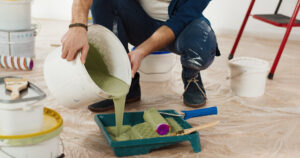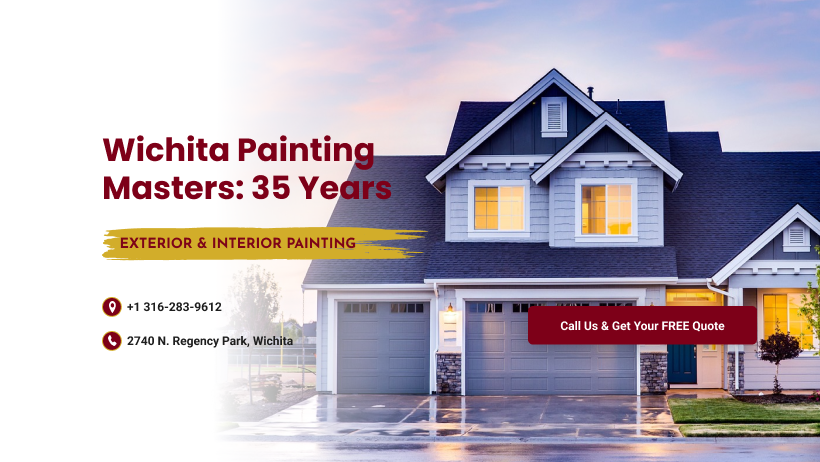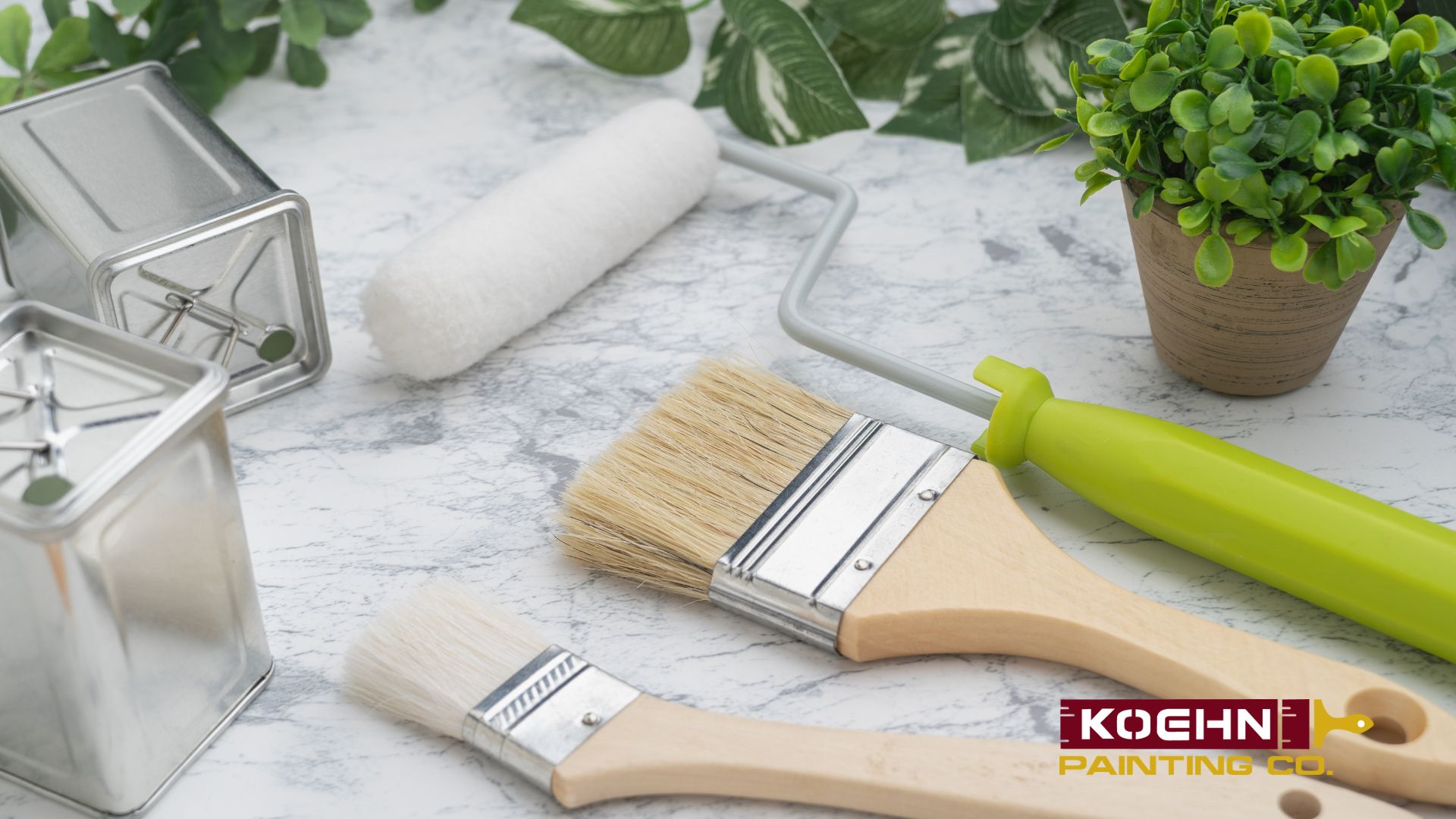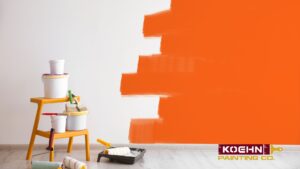Table of Contents
ToggleSection 1: Basics of Painting Costs
Painting, both external and internal, involves several essential steps that guarantee durability and aesthetic value. For exterior painting, the process begins with thoroughly cleaning the home’s surface, often including power washing to remove dirt, mold, and old paint. This phase is followed by repairing damaged areas, sanding, and applying primer, which is especially important for areas exposed to adverse weather conditions. The final step is the application of a high-quality exterior paint designed to withstand the elements.
While similar in preparation, interior painting focuses more on protecting the interior and furniture. It requires different types of paint, such as those with lower volatile organic compounds (VOCs), to maintain indoor air quality. The process typically involves sealing edges, covering furniture, repairing wall imperfections, applying primer (if necessary), and finally, painting with your chosen colors and finishes.
A myriad of factors can influence the interior painting cost:
- Labor
- Materials
- The size and complexity
- Geographic location
Contractors typically use several pricing models to determine the cost of a painting project. One standard method is a flat rate, where a single price is quoted for the entire job based on an assessment of the work required. This straightforward model helps clients understand their total expenses upfront.
Another popular pricing strategy is per-square-foot pricing. Here, contractors charge a set fee for each square foot of surface to be painted, which can simplify the estimation process for both large and small projects.
Hourly rates are also used, especially for projects that may vary in scope or have undefined complexities. Contractors charge for the time spent on the job, which can benefit jobs requiring high detail and craftsmanship.
Some contractors also offer tiered pricing based on the materials’ quality, allowing clients to choose between different levels of paint quality and corresponding prices, balancing cost with desired outcome and durability.
2. Average Costs of Exterior Painting

Painting costs in the United States can vary significantly by location due to some regional factors. These include local climate conditions, labor market rates, and the cost of materials. For example, areas with adverse weather conditions, such as coastal regions where salt spray is frequent, often require more durable paints and more frequent applications, which can increase costs. According to HomeAdvisor, the average cost to paint a home’s exterior in the United States ranges from $1,810 to $4.506.
The average costs of exterior painting in the United States can vary significantly based on several factors, including the type of siding, the condition of the surfaces, and geographic location. Here’s a general breakdown of average costs nationwide:
- Overall Range: The cost to paint the exterior of a house typically ranges from $1,700 to $9,400, depending on various factors such as the size of the house and the type of paint and materials used.
- Per Square Foot: The cost generally falls between $1.00 and $5.50 per square foot. For specific materials, costs can vary:
- Wood siding: $1 to $4 per square foot.
- Stucco: $1 to $5.50 per square foot.
- Vinyl siding: $1 to $3 per square foot.
- Brick: $1.50 to $4.50 per square foot.
- Aluminum/Metal: $1 to $4 per square foot.
- Concrete: $1 to $3.50 per square foot
Factors that affect the cost of exterior painting
- Permit Requirements: While exterior painting typically does not require permits, structural changes like siding replacement may require a permit, costing between $200 and $300.
- Preparation Work: Prep work is essential and can be extensive, often making up a significant portion of the project. Costs for preparing your home’s exterior can range from $0.50 to $2.50 per square foot, covering activities such as power washing, sanding, and caulking.
- Access Challenges: The ease of access to different parts of your home affects the cost. Painting lower stories is generally cheaper than higher ones, where scaffolding or lifts might be required.
- Additional Costs: Discuss with your contractor whether specific elements like trim painting are included in the overall quote. Painting exterior trim may cost an additional $1 to $6 per linear foot.
- Seasonality: Weather conditions play a crucial role in planning painting projects. Spring and fall are ideal for painting in many regions of the United States due to warmer weather, leading to greater demand and perhaps higher prices during these peak seasons.
- Tropical Regions (e.g., Southern Florida, Hawaii): The tropical climate, characterized by a wet and a dry season, affects when painting projects can ideally be scheduled. The dry season is generally preferred due to less rain and more consistent weather patterns, reducing the risk of paint not setting correctly due to high humidity or sudden downpours. This means you should choose a date between October and March.
- Cold Climates (e.g., Northern States, Canada): In colder regions, painting outdoors is often limited to the short summer months when temperatures are consistently above freezing. Paint requires certain minimum temperatures to dry and cure properly. Therefore, late spring to early fall represents the optimal window for painting projects. You might also wait until early or late summer.
- Desert Regions (e.g., Southwestern States like Arizona and Nevada): These areas experience incredibly high summer temperatures, which can cause paint to dry too rapidly, leading to poor adhesion and potential cracking. Early spring and late fall are more suitable for painting because the temperatures are more moderate.
- Mountainous Areas (e.g., Colorado, the Rocky Mountains): Higher elevations can experience more significant temperature swings and an earlier onset of cold weather. Painting is best done in the late spring and summer when warmer temperatures ensure proper drying and curing between late April and early October.
The cost of exterior painting varies significantly across different regions in the United States due to climate, labor costs, and the type of materials typically used. In the Northeast, exterior painting costs range from $3,000 to $6,000, reflecting the region’s fluctuating weather conditions and higher living costs. The Midwest offers slightly lower rates, ranging from $2,500 to $5,000, due to more moderate weather and lower costs of living.
In the South, the costs are even lower, from $2,000 to $4,000, facilitated by generally milder weather that extends the painting season. Conversely, the West sees the highest costs, between $3,500 and $7,000, likely due to its vast geographical differences and the high cost of living in coastal areas.
Here are detailed case studies or examples of exterior painting costs from different regions across the United States, reflecting the regional variations due to factors like climate, labor rates, and material costs:
- Northeast (Boston, MA)
In Boston, Massachusetts, the cost to paint a home’s exterior can range from $3,000 to $5,000. This higher cost range reflects the Northeast’s variable climate, which can include harsh winters and humid summers. This can increase the need for durable, weather-resistant paint and possibly more frequent maintenance.
- Midwest (Chicago, IL)
In Chicago, Illinois, homeowners might spend between $4,632 and $8,326 on painting a 500- to 1500-square-foot surface. The Midwest generally has more extreme seasonal variations, which can affect the timing and type of paint used, thus affecting the overall cost.
- South (Atlanta, GA)
Atlanta, Georgia, in the South, sees exterior painting prices between $2,000 to $5,000. This region’s milder and warmer climate often allows for a longer painting season with less need for highly weather-resistant paint, which can help lower costs.
- West (San Francisco, CA)
On the higher end of the spectrum, exterior painting costs in San Francisco, California, range from $3,500 to $7,000. The cost is elevated due to the high cost of living, stringent environmental regulations that may require specialized products and the diverse climate across different parts of California.
3. Average Costs of Interior Painting
Factors that affect interior painting cost

- Size and Structure of the Home: A larger home will naturally cost more to paint due to the greater surface area. Additionally, homes with multiple stories or complex layouts may incur higher costs because of the extra effort required to move and set up equipment on different levels.
Kitchens and bathrooms often require more expensive, moisture-resistant paints and may involve complex surfaces around cabinets and fixtures, driving up the cost. Bedrooms and living rooms typically cost less to paint, but the price can increase if high ceilings or intricate trim work are involved. The size of the room directly impacts the amount of paint and labor required, with larger rooms costing more to cover adequately.
- Furniture and Obstacles: You can save on costs by moving furniture yourself. If the painting team handles this, the overall cost could increase due to the additional labor involved.
- Wall Condition: Preparing walls that require repairs due to damage or wear and tear will add to the cost. It’s often more economical to handle these repairs during a painting project to ensure the best finish.
- Additional Considerations: Textured walls, such as those with an “orange peel” or popcorn finish, can increase painting costs by up to 50% because they require more paint than smooth walls. Similarly, accent walls or rooms with exceptionally high ceilings may raise prices due to the additional labor and materials needed.
Below, you can find generic examples based on geographical locations. We have selected major cities from each location as examples.
- Northeast (Boston, MA)
Interior painting costs in Boston, Massachusetts, reflect the region’s high cost of living and specific needs due to its variable climate, which includes cold winters and humid summers. The cost to paint the interior of a home may range from $3,000 to $5,500. Specialized paints may be required to handle moisture from indoor heating systems during the winter, adding to the expense.
- Midwest (Chicago, IL)
In Chicago, Illinois, the cost of interior painting can vary widely, often between $4,612 to $9,836 for a standard-sized home. This variation is due to extreme seasonal changes, which can influence the timing of indoor projects and the types of materials used to ensure durability against indoor heating and cooling effects.
- South (Atlanta, GA)
Atlanta, Georgia’s milder and warmer climate typically results in lower interior painting costs, ranging from $4,421.00 to $7,925.00. The extended painting season and less need for specialty paints contribute to more competitive regional pricing.
- West (San Francisco, CA)
San Francisco, California, has some of the highest interior painting costs, generally ranging from $6,000 to $11,000. This is influenced by the high cost of living and stringent environmental regulations. The diverse microclimates across the city necessitate various paint types and preparations to address local conditions effectively.
DIY and professional painting: cost comparisons
When considering painting a property, one of the first decisions is whether to undertake the DIY (do it yourself) project or hire professionals. The decision largely depends on the project’s scope, the job’s complexity, and the homeowner’s skill level.
For smaller, more straightforward projects, DIY can be significantly cheaper. The main cost for DIY painting is materials, ranging from $200 to $300 for a typical room. In contrast, hiring professionals for the same room can cost anywhere from $400 to $1,500, including labor, representing a substantial portion of the cost. On average, expect to pay professional painters between $20 and $50 per hour.
However, DIY projects can also risk higher expenses due to potential mistakes, such as purchasing the wrong materials or redoing the work. Professional painters bring expertise, efficiency, and equipment, which can result in higher upfront costs but potentially better, longer-lasting results. Additionally, they often obtain materials at lower wholesale rates and can work faster, which is critical on larger or more complex projects.
Using the right techniques, such as proper surface preparation and applying the correct number of coats, is critical to maximizing the life of a paint job. Professional painters are experts in these techniques, which can make higher initial costs cheaper over time.
Investing in good brushes, rollers, and other tools for homeowners doing DIY is also crucial. Quality tools help achieve a more professional finish and can be reused for multiple projects, spreading the costs over time.
4. Factors Affecting Painting Costs
An in-depth examination of key cost drivers reveals the crucial elements that significantly influence the financial aspects of a potential painting project:
- Labor: The job’s complexity and the painters’ skill level are significant cost factors.
- The more complex the project, the higher the labor costs. This includes detailed and intricate designs, patterns that require precision, and surfaces that are difficult to access or prepare. Complex jobs often require more skilled painters who command higher wages.
- Skilled painters usually charge more for their services because they can deliver higher-quality finishes and efficiently handle more complicated tasks. Their expertise can also mean better handling unexpected issues during a project.
- Projects that involve high places or hazardous conditions (like high-rise buildings or industrial sites with toxic materials) require additional safety measures. These might include scaffolding, safety harnesses, and other equipment, which increase the overall cost due to the extra time needed for setup and compliance with safety regulations.
- Labor typically accounts for most of the total cost. It is calculated based on the complexity and size of the job, with professionals often estimating the time it will take to complete the project. Labor costs are generally higher in metropolitan areas than in rural regions. According to the Bureau of Labor Statistics, the average hourly wage for painters in the United States can range from $18 to $37, but in cities like San Francisco or Washington D.C., these rates can go much higher.
- Materials: The type of paint, primer, and additional materials, such as caulk or sealant, can significantly affect costs. High-end paints with specialized features like mold resistance or energy efficiency can stretch your budget.
- Acrylic Paints: These water-based paints are known for their durability and ease of use on most surfaces. Their durable finish and UV resistance make them ideal for high-traffic areas and rooms that receive a lot of natural light.
- Enamel Paints are typically oil-based and known for creating a hard, durable finish. They are ideal for surfaces that require frequent cleaning, like kitchen cabinets and trims. However, enamel paints can take longer to dry and often have a strong odor.
- Latex Paints: These are water-based, like acrylics, but tend to dry faster and are generally less expensive. Latex paints are versatile and emit fewer fumes, making them a good choice for large rooms and areas that need to be used soon after painting.
- Primers and SealersPrimers: Essential for preparing surfaces, primers help paint adhere better and provide a smoother finish. They are particularly important for covering dark colors or stained surfaces. Oil-based primers are great for wood as they seal the porous surface and prevent tannins from bleeding. Sealers protect the paint and underlying surface. They are often applied as a first coat to create a barrier against moisture and stains, especially on surfaces like plaster or old varnish that might interact negatively with new paint.
- Other materials such as primers, brushes, rollers, and tarps can add 10-20% to the project’s material costs. Specialized equipment such as ladders and scaffolding may also be required for outdoor work, especially for multi-story buildings, which adds to the overall expense.
- The size and complexity of a painting job significantly impact the overall costs involved. Larger homes or buildings require more paint and materials, and the surface area to be covered increases labor hours, directly affecting the total price.
Complex architectural features such as high ceilings, intricate trims, or multiple stories add to the complexity and may necessitate specialized equipment or techniques. This can include scaffolding or lifts, which further increases labor costs. Additionally, homes with unique textures or surfaces that require extra preparation work, such as patching or sanding, also contribute to higher costs due to the additional time and materials needed for adequate preparation.
- Geographic Location: Costs may vary significantly by region due to differences in labor rates, cost of living, and local environmental regulations that may require unique products or preparations. Painting costs vary widely across the United States due to differences in climate, labor rates, and availability of materials.
5. Cost-Saving Tips for Painting Projects

Investing in high-quality paints and applying the correct techniques can offer long-term savings by reducing the frequency of repainting. Premium paints with higher-quality pigments and binders resist fading, chalking, and blistering better than cheaper alternatives.
While the initial cost may be higher (premium paint can cost twice as much as basic paint), the long-term durability typically justifies the expense. Quality paints can last up to 15 years on an exterior surface, compared to 4 years for a lower-quality product.
Seasonal discounts and timing: Optimal timing for painting projects
The timing of a painting project can significantly impact its cost. Weather conditions play a crucial role, especially for exterior painting. Optimal conditions for painting are generally found in late spring and early fall when there is less rain and moderate temperatures, which help the paint cure properly.
Taking advantage of off-peak seasons can lead to cost savings. Due to decreased demand, many painting contractors offer lower rates during the winter months. For example, painting during the winter can save homeowners an average of 10-20% off peak season prices. Additionally, paint stores often have sales during these times, providing additional cost-saving opportunities.
6. How to Choose the Right Paint and Contractor
Choosing the right contractor for value and quality involves careful consideration and research. Start by seeking recommendations from trusted sources and checking online reviews to gauge the reputation of potential contractors. Once you have a shortlist, verify their credentials, including licensing and insurance, to ensure they meet professional standards. Request detailed quotes from multiple contractors to compare prices and scope of work, but remember that the cheapest option may not always offer the best value. Importantly, ask for references and examples of past work to assess the quality of their workmanship.
Guide to Selecting Paints
When selecting paints, consider the brand, finish, and purpose tailored to your project needs:
- Brands: Opt for reputable brands known for quality and durability. Research reviews and ratings to see how various brands stand up over time in similar environments.
- Finishes: Depending on the room’s function and required durability, choose from matte, satin, eggshell, semi-gloss, or gloss. Glossier finishes are better for high-traffic areas due to their ease of cleaning.
- Purposes: Specialized paints, such as mold-resistant options for bathrooms or eco-friendly options, can address specific needs. Ensure the paint’s properties align with the intended use and environmental conditions.
Tips on Vetting and Selecting Painting Contractors
Selecting the right painting contractor is crucial for ensuring quality:
- Research: Look up reviews and testimonials from previous customers. Platforms like Yelp, Angie’s List, or Google Reviews provide insights into others’ experiences.
- Credentials: Verify that the contractor is licensed, insured, and bonded. This protects you from liability and ensures a level of professionalism.
- Quotes: Obtain multiple detailed quotes to compare pricing and scope. Be wary of quotes that are significantly lower than others, which could indicate subpar materials or workmanship.
Understanding Quotes and Contracts
To avoid hidden costs and ensure clarity in painting projects:
- Ensure the quote includes detailed breakdowns of labor, materials, and any additional charges. Ask about any potential extra costs that could arise.
- Read contracts thoroughly before signing. Look for clear work descriptions, timelines, payment schedules, and cancellation policies. Feel free to ask for clarifications on any vague or complicated terms.
7. Regulatory and Environmental Considerations
In the United States, painting contractors must navigate local regulations that can significantly impact project costs. These regulations may involve specific permits for painting within historic neighborhoods, compliance with local environmental standards, and even specific periods during which painting may occur to minimize disruption. For example, cities like San Francisco require special permits for exterior alterations in historic neighborhoods, which can increase the time and cost of a painting project.
Insurance and licensing are critical components that ensure quality and protect the service provider and the customer. However, they also increase the cost of painting projects. For example, painters must carry liability insurance to cover damages that may occur during a project, and workers’ compensation insurance is necessary to protect employees.
8. Future Trends in Painting Costs
The cost of painting materials and labor is expected to continue to fluctuate. With rising global demand for raw materials and supply chain disruptions, paint prices may trend upwards. Labor costs are also likely to increase due to the growing shortage of skilled labor in construction and renovation. Labor costs are expected to increase by 3-5% annually over the next five years, impacting the overall cost of painting projects.
Technological advances are set to transform the painting industry. New tools such as automated and robotic painting systems are already being tested, which promise to speed up the painting process and reduce labor costs. Additionally, innovations in paint formulations that allow for faster drying times and longer-lasting finishes could reduce the frequency of repainting, thus reducing long-term costs.
9. Discover Koehn

Discover the unparalleled craftsmanship and quality of Koehn Painting, the premier painting service provider in Wichita, Kansas. At Koehn Painting, we prioritize quality above all, ensuring each stroke and color selection enhances the beauty and longevity of your property. Our commitment to excellence makes us the top choice for discerning homeowners and businesses.
Don’t settle for less when it comes to transforming your space. Contact Koehn Painting today to discuss your next project and receive a personalized quote. Experience the difference that professional quality makes. Let us help you bring your vision to life with precision and expertise.
Reach out to Koehn Painting – where quality paints a beautiful future.





